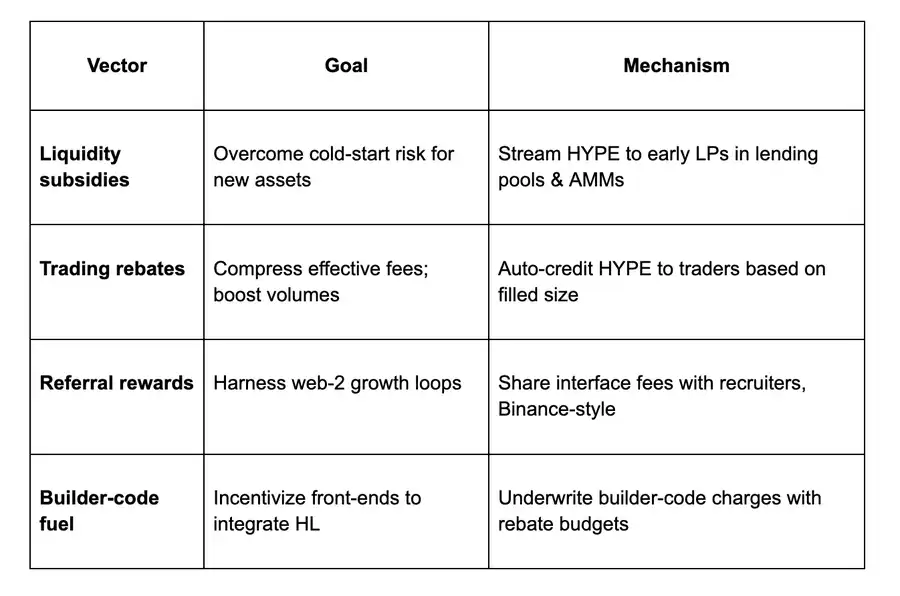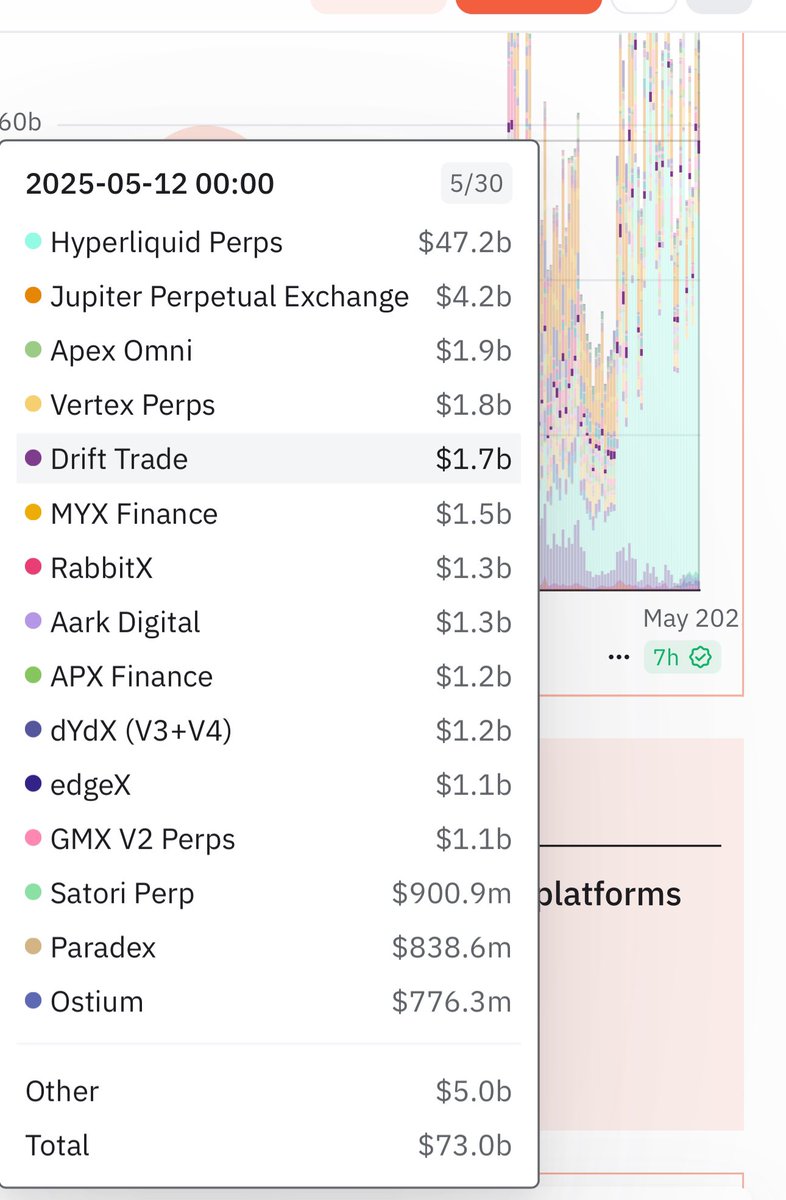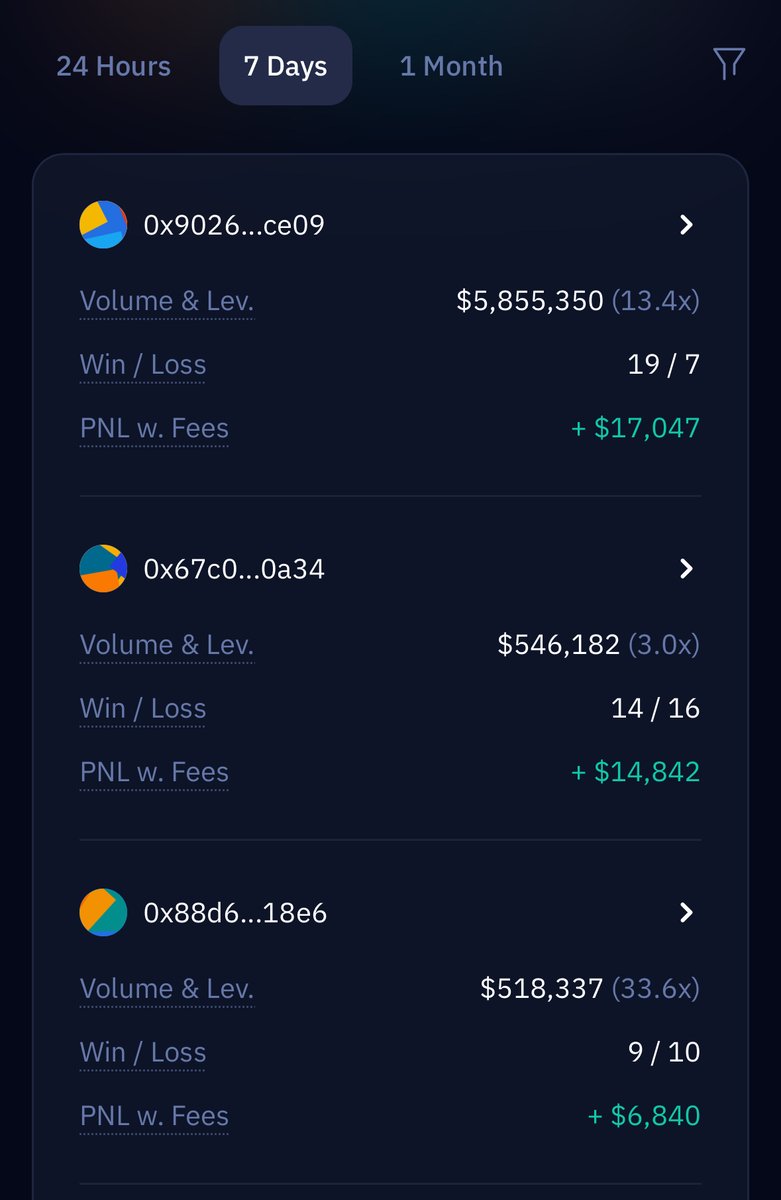
GMX
GMX price
$14.6400
-$0.81000
(-5.25%)
Price change for the last 24 hours

How are you feeling about GMX today?
Share your sentiments here by giving a thumbs up if you’re feeling bullish about the coin or a thumbs down if you’re feeling bearish.
Vote to view results
Disclaimer
The social content on this page ("Content"), including but not limited to tweets and statistics provided by LunarCrush, is sourced from third parties and provided "as is" for informational purposes only. OKX does not guarantee the quality or accuracy of the Content, and the Content does not represent the views of OKX. It is not intended to provide (i) investment advice or recommendation; (ii) an offer or solicitation to buy, sell or hold digital assets; or (iii) financial, accounting, legal or tax advice. Digital assets, including stablecoins and NFTs, involve a high degree of risk, can fluctuate greatly. The price and performance of the digital assets are not guaranteed and may change without notice.
OKX does not provide investment or asset recommendations. You should carefully consider whether trading or holding digital assets is suitable for you in light of your financial condition. Please consult your legal/tax/investment professional for questions about your specific circumstances. For further details, please refer to our Terms of Use and Risk Warning. By using the third-party website ("TPW"), you accept that any use of the TPW will be subject to and governed by the terms of the TPW. Unless expressly stated in writing, OKX and its affiliates (“OKX”) are not in any way associated with the owner or operator of the TPW. You agree that OKX is not responsible or liable for any loss, damage and any other consequences arising from your use of the TPW. Please be aware that using a TPW may result in a loss or diminution of your assets. Product may not be available in all jurisdictions.
OKX does not provide investment or asset recommendations. You should carefully consider whether trading or holding digital assets is suitable for you in light of your financial condition. Please consult your legal/tax/investment professional for questions about your specific circumstances. For further details, please refer to our Terms of Use and Risk Warning. By using the third-party website ("TPW"), you accept that any use of the TPW will be subject to and governed by the terms of the TPW. Unless expressly stated in writing, OKX and its affiliates (“OKX”) are not in any way associated with the owner or operator of the TPW. You agree that OKX is not responsible or liable for any loss, damage and any other consequences arising from your use of the TPW. Please be aware that using a TPW may result in a loss or diminution of your assets. Product may not be available in all jurisdictions.
GMX market info
Market cap
Market cap is calculated by multiplying the circulating supply of a coin with its latest price.
Market cap = Circulating supply × Last price
Market cap = Circulating supply × Last price
Circulating supply
Total amount of a coin that is publicly available on the market.
Market cap ranking
A coin's ranking in terms of market cap value.
All-time high
Highest price a coin has reached in its trading history.
All-time low
Lowest price a coin has reached in its trading history.
Market cap
$148.19M
Circulating supply
10,136,305 GMX
76.50% of
13,250,000 GMX
Market cap ranking
--
Audits

Last audit: Jun 3, 2021
24h high
$15.5800
24h low
$14.1500
All-time high
$91.4100
-83.99% (-$76.7700)
Last updated: Apr 18, 2023
All-time low
$9.5600
+53.13% (+$5.0800)
Last updated: Apr 7, 2025
GMX Feed
The following content is sourced from .

ChainCatcher 链捕手
Original title: "What does it mean to be a Hyperliquid-aligned fiat stable?"
Author: husd_fiat
Compilation: zhouzhou, BlockBeats
Editor's note: HUSD is a public stablecoin project launched by Hyperliquid, which returns stablecoin interest to the ecosystem for repurchasing HYPE, subsidizing interface rates, and supporting the Builder Code model to promote ecological growth. It breaks the USDC/Tether model and allows funds to no longer flow to centralized institutions, but to feed back the community and product development.
The following is the original content (the original content has been edited for ease of reading and comprehension):
Something that the ecosystem really needs
HUSD's story is about how to disrupt a multi-billion dollar stablecoin market. Hyperliquid initially emerged as a leading perpetual contract decentralized exchange (perp DEX), outperforming older players like DYDX and GMX. As the product continued to attract new users and was gradually introduced to the spot market, Hyperliquid evolved into a Binance/Coinbase competitor. Next, the ecosystem will be challenged by the fiat stablecoin duopolys of Circle and Tether.
Currently, approximately $2.5 billion in cross-chain USDC is locked in HyperCore's order book and earns about 4.3% in interest earnings. These earnings could generate approximately $107.5 million annually for Circle Internet Financial into its private balance sheet. With each new USDC deposit into Hyperliquid, Circle's cash flow is further expanded. But what if that value doesn't go to Circle, but instead goes to grow the Hyperliquid ecosystem? Why should we be tied down by the outdated traditional stablecoin model of USDC when there is an opportunity to break out of the existing framework?
The opportunity cost of choosing to inherit the old stablecoin
As Hyperliquid's influence in on-chain trading continues to expand, so does the net deposits of fiat stablecoins, providing liquidity to the perpetual contract market and spot market. In a future where Hyperliquid grows 10x, 100x, or even 1000x, the opportunity cost of continuing to use traditional stablecoins will get higher and higher. This value from the stablecoin layer will either continue to flow to Circle and Tether's balance sheets, or flow back into Hyperliquid's own ecosystem.
A new stablecoin model tailored for Hyperliquid
The Assistance Fund, through the automatic buyback of HYPE, has proven that the cash flow generated by the agreement can and should be directly returned to the community. In the past 30 days alone, the aid fund has recovered millions of dollars in HYPE from the market.
HUSD continues this strategy, but at the stablecoin level: initially, a large portion of the interest income generated by HUSD will be used to purchase HYPE, which will then be deployed in various growth directions of the Hyperliquid ecosystem. In other words, every time you use HUSD, you add buying pressure to HYPE and reinvest value into Hyperliquid's growth.
How will the repurchased HYPE be used?
HUSD: Fueling the future of Builder Code
HUSD has played a key role in driving the explosion of the "Builder Code" business model. The Builder Code is a native feature of Hyperliquid that allows an interface operator to charge a fee for spot or futures trades submitted on behalf of a user. Its goal is to monetize Hyperliquid's "last-mile distribution" — meaning that anyone who can effectively attract and retain users can use Builder Code to build a trading business that is not limited by technology or liquidity.
The unit economics of this type of business can be substantial, but at this early stage, new brands are still facing a "cold start" and the moat between the different interfaces is not yet obvious. The advent of HUSDs can help these "Hyperliquid hybrids" kick off and provide a way to differentiate themselves from each other.
By subsidizing the cost of the Builder Code by HUSD, the interface can charge the user more than it would otherwise be, without increasing the cost to the user. The interface captures revenue in real-time and further leverages those funds for growth strategies.
Let's take this as an example: Let's say Interface XYZ gets a rebate budget of 100 HUSD. All futures transactions with their Builder Code will be counted by the system, and the rebate balance of the corresponding user will continue to grow. The interface can handle at least about $100,000 in contract volume (i.e., 100 HUSD divided by 0.1% fee rate) before users actually start incurring fees. At the same time, interface operators can reinvest the revenue generated by Builder Code into user acquisition or user retention.
This is how HUSD is powering the "real-time growth" of the Hyperliquid ecosystem.
summary
HUSD combines two core insights: the denominated asset (stablecoin) used for trading and the cash flow generated by it, all within the trading platform. The end result is a stablecoin of the nature of a "public good", which transforms the originally static reserve interest into the active and compounding growth of the Hyperliquid ecosystem.
HUSD is a public goods project run by Felix and supported by community members, and it will go live through the Felix Points system. This deployment also builds on the foundation laid by @m0foundation, and it is its vision of a "global stablecoin platform" that makes HUSD possible.
Hyperliquid has upended the centralized exchange landscape, and HUSD is poised to do the same with traditional fiat stablecoins.
Show original

10.21K
0

Blockbeats
Original title: What does it mean to be a Hyperliquid-aligned fiat stable?
The original author @husd_fiat
Original compilation: zhouzhou, BlockBeats
Editor's note: HUSD is a public stablecoin project launched by Hyperliquid, which returns stablecoin interest to the ecosystem for repurchasing HYPE, subsidizing interface rates, and supporting the Builder Code model to promote ecological growth. It breaks the USDC/Tether model and allows funds to no longer flow to centralized institutions, but to feed back the community and product development.
The following is the original content (the original content has been edited for ease of reading and comprehension):
Something that the ecosystem really needs
HUSD's story is about how to disrupt a multi-billion dollar stablecoin market. Hyperliquid initially emerged as a leading perpetual contract decentralized exchange (perp DEX), outperforming older players like DYDX and GMX. As the product continued to attract new users and was gradually introduced to the spot market, Hyperliquid evolved into a Binance/Coinbase competitor. Next, the ecosystem will be challenged by the fiat stablecoin duopolys of Circle and Tether.
Currently, approximately $2.5 billion in cross-chain USDC is locked in HyperCore's order book and earns about 4.3% in interest earnings. These earnings could generate approximately $107.5 million annually for Circle Internet Financial into its private balance sheet. With each new USDC deposit into Hyperliquid, Circle's cash flow is further expanded. But what if that value doesn't go to Circle, but instead goes to grow the Hyperliquid ecosystem? Why should we be tied down by the outdated traditional stablecoin model of USDC when there is an opportunity to break out of the existing framework?
The opportunity cost of choosing to inherit the old stablecoin
As Hyperliquid's influence in on-chain trading continues to expand, so does the net deposits of fiat stablecoins, providing liquidity to the perpetual contract market and spot market. In a future where Hyperliquid grows 10x, 100x, or even 1000x, the opportunity cost of continuing to use traditional stablecoins will get higher and higher. This value from the stablecoin layer will either continue to flow to Circle and Tether's balance sheets, or flow back into Hyperliquid's own ecosystem.
A new stablecoin model tailored for Hyperliquid
The Assistance Fund, through the automatic buyback of HYPE, has proven that the cash flow generated by the agreement can and should be directly returned to the community. In the past 30 days alone, the aid fund has recovered millions of dollars in HYPE from the market.
HUSD continues this strategy, but at the stablecoin level: initially, a large portion of the interest income generated by HUSD will be used to purchase HYPE, which will then be deployed in various growth directions of the Hyperliquid ecosystem. In other words, every time you use HUSD, you add buying pressure to HYPE and reinvest value into Hyperliquid's growth.
How will the repurchased HYPE be used?
HUSD: Fueling the future of Builder Code
HUSD has played a key role in driving the explosion of the "Builder Code" business model. The Builder Code is a native feature of Hyperliquid that allows an interface operator to charge a fee for spot or futures trades submitted on behalf of a user. Its goal is to monetize Hyperliquid's "last-mile distribution" — meaning that anyone who can effectively attract and retain users can use Builder Code to build a trading business that is not limited by technology or liquidity.
The unit economics of this type of business can be substantial, but at this early stage, new brands are still facing a "cold start" and the moat between the different interfaces is not yet obvious. The advent of HUSDs can help these "Hyperliquid hybrids" kick off and provide a way to differentiate themselves from each other.
By subsidizing the cost of the Builder Code by HUSD, the interface can charge the user more than it would otherwise be, without increasing the cost to the user. The interface captures revenue in real-time and further leverages those funds for growth strategies.
Let's take this as an example: Let's say Interface XYZ gets a rebate budget of 100 HUSD. All futures transactions with their Builder Code will be counted by the system, and the rebate balance of the corresponding user will continue to grow. The interface can handle at least about $100,000 in contract volume (i.e., 100 HUSD divided by 0.1% fee rate) before users actually start incurring fees. At the same time, interface operators can reinvest the revenue generated by Builder Code into user acquisition or user retention.
This is how HUSD is powering the "real-time growth" of the Hyperliquid ecosystem.
summary
HUSD combines two core insights: the denominated asset (stablecoin) used for trading and the cash flow generated by it, all within the trading platform. The end result is a stablecoin of the nature of a "public good", which transforms the originally static reserve interest into the active and compounding growth of the Hyperliquid ecosystem.
HUSD is a public goods project run by Felix and supported by community members, and it will go live through the Felix Points system. This deployment also builds on the foundation laid by @m0foundation, and it is its vision of a "global stablecoin platform" that makes HUSD possible.
Hyperliquid has upended the centralized exchange landscape, and HUSD is poised to do the same with traditional fiat stablecoins.
「Original link」
Show original

14.42K
0

Kevin Ding reposted

蓝狐
In less than a cycle, the once-leading dydx's trading volume has been far surpassed by hyperliquid. There are two questions:
First, if dydx (@dYdX) hadn't focused its efforts on building its own chain, would its situation be better than it is now?
Second, given the current rate of replacement, will hyperliquid (@HyperliquidX) continue to maintain its leading position? Previously, dydx was surpassed by gmx, and then gmx was surpassed by hyper. Where exactly is the moat of perp dex? How deep is it?
Show original
29.89K
78

MUX Protocol reposted

MUX Protocol
BTC retesting $101k while ETH held firm made for some excellent trading opportunities this week.
MUX prioritizes routing BTC and ETH trades to venues with 0% spread & 0% price impact, like GMX’s GLP Pool and the MUXLP.
When cost is friction, your trades deserve a better route.

8.33K
4
GMX price performance in USD
The current price of GMX is $14.6400. Over the last 24 hours, GMX has decreased by -5.24%. It currently has a circulating supply of 10,136,305 GMX and a maximum supply of 13,250,000 GMX, giving it a fully diluted market cap of $148.19M. At present, the GMX coin holds the 0 position in market cap rankings. The GMX/USD price is updated in real-time.
Today
-$0.81000
-5.25%
7 days
-$1.0400
-6.64%
30 days
-$0.81000
-5.25%
3 months
-$5.0200
-25.54%
Popular GMX conversions
Last updated: 05/19/2025, 23:34
| 1 GMX to USD | $14.6200 |
| 1 GMX to EUR | €12.9874 |
| 1 GMX to PHP | ₱814.29 |
| 1 GMX to IDR | Rp 240,421.0 |
| 1 GMX to GBP | £10.9344 |
| 1 GMX to CAD | $20.3837 |
| 1 GMX to AED | AED 53.6982 |
| 1 GMX to VND | ₫379,346.1 |
About GMX (GMX)
The rating provided is an aggregated rating collected by OKX from the sources provided and is for informational purpose only. OKX does not guarantee the quality or accuracy of the ratings. It is not intended to provide (i) investment advice or recommendation; (ii) an offer or solicitation to buy, sell or hold digital assets; or (iii) financial, accounting, legal or tax advice. Digital assets, including stablecoins and NFTs, involve a high degree of risk, can fluctuate greatly, and can even become worthless. The price and performance of the digital assets are not guaranteed and may change without notice. Your digital assets are not covered by insurance against potential losses. Historical returns are not indicative of future returns. OKX does not guarantee any return, repayment of principal or interest. OKX does not provide investment or asset recommendations. You should carefully consider whether trading or holding digital assets is suitable for you in light of your financial condition. Please consult your legal/ tax/ investment professional for questions about your specific circumstances.
Show more
- Official website
- Github
- Block explorer
About third-party websites
About third-party websites
By using the third-party website ("TPW"), you accept that any use of the TPW will be subject to and governed by the terms of the TPW. Unless expressly stated in writing, OKX and its affiliates ("OKX") are not in any way associated with the owner or operator of the TPW. You agree that OKX is not responsible or liable for any loss, damage and any other consequences arising from your use of the TPW. Please be aware that using a TPW may result in a loss or diminution of your assets.
GMX FAQ
How much is 1 GMX worth today?
Currently, one GMX is worth $14.6400. For answers and insight into GMX's price action, you're in the right place. Explore the latest GMX charts and trade responsibly with OKX.
What is cryptocurrency?
Cryptocurrencies, such as GMX, are digital assets that operate on a public ledger called blockchains. Learn more about coins and tokens offered on OKX and their different attributes, which includes live prices and real-time charts.
When was cryptocurrency invented?
Thanks to the 2008 financial crisis, interest in decentralized finance boomed. Bitcoin offered a novel solution by being a secure digital asset on a decentralized network. Since then, many other tokens such as GMX have been created as well.
Will the price of GMX go up today?
Check out our GMX price prediction page to forecast future prices and determine your price targets.
Monitor crypto prices on an exchange
Watch this video to learn about what happens when you move your money to a crypto exchange.
ESG Disclosure
ESG (Environmental, Social, and Governance) regulations for crypto assets aim to address their environmental impact (e.g., energy-intensive mining), promote transparency, and ensure ethical governance practices to align the crypto industry with broader sustainability and societal goals. These regulations encourage compliance with standards that mitigate risks and foster trust in digital assets.
Asset details
Name
OKcoin Europe LTD
Relevant legal entity identifier
54930069NLWEIGLHXU42
Name of the crypto-asset
GMX
Consensus Mechanism
GMX is present on the following networks: arbitrum, avalanche.
Arbitrum is a Layer 2 solution on top of Ethereum that uses Optimistic Rollups to enhance scalability and reduce transaction costs. It assumes that transactions are valid by default and only verifies them if there's a challenge (optimistic): Core Components: • Sequencer: Orders transactions and creates batches for processing. • Bridge: Facilitates asset transfers between Arbitrum and Ethereum. • Fraud Proofs: Protect against invalid transactions through an interactive verification process. Verification Process: 1. Transaction Submission: Users submit transactions to the Arbitrum Sequencer, which orders and batches them. 2. State Commitment: These batches are submitted to Ethereum with a state commitment. 3. Challenge Period: Validators have a specific period to challenge the state if they suspect fraud. 4. Dispute Resolution: If a challenge occurs, the dispute is resolved through an iterative process to identify the fraudulent transaction. The final operation is executed on Ethereum to determine the correct state. 5. Rollback and Penalties: If fraud is proven, the state is rolled back, and the dishonest party is penalized. Security and Efficiency: The combination of the Sequencer, bridge, and interactive fraud proofs ensures that the system remains secure and efficient. By minimizing on-chain data and leveraging off-chain computations, Arbitrum can provide high throughput and low fees.
The Avalanche blockchain network employs a unique Proof-of-Stake consensus mechanism called Avalanche Consensus, which involves three interconnected protocols: Snowball, Snowflake, and Avalanche. Avalanche Consensus Process 1. Snowball Protocol: o Random Sampling: Each validator randomly samples a small, constant-sized subset of other validators. Repeated Polling: Validators repeatedly poll the sampled validators to determine the preferred transaction. Confidence Counters: Validators maintain confidence counters for each transaction, incrementing them each time a sampled validator supports their preferred transaction. Decision Threshold: Once the confidence counter exceeds a pre-defined threshold, the transaction is considered accepted. 2. Snowflake Protocol: Binary Decision: Enhances the Snowball protocol by incorporating a binary decision process. Validators decide between two conflicting transactions. Binary Confidence: Confidence counters are used to track the preferred binary decision. Finality: When a binary decision reaches a certain confidence level, it becomes final. 3. Avalanche Protocol: DAG Structure: Uses a Directed Acyclic Graph (DAG) structure to organize transactions, allowing for parallel processing and higher throughput. Transaction Ordering: Transactions are added to the DAG based on their dependencies, ensuring a consistent order. Consensus on DAG: While most Proof-of-Stake Protocols use a Byzantine Fault Tolerant (BFT) consensus, Avalanche uses the Avalanche Consensus, Validators reach consensus on the structure and contents of the DAG through repeated Snowball and Snowflake.
Incentive Mechanisms and Applicable Fees
GMX is present on the following networks: arbitrum, avalanche.
Arbitrum One, a Layer 2 scaling solution for Ethereum, employs several incentive mechanisms to ensure the security and integrity of transactions on its network. The key mechanisms include: 1. Validators and Sequencers: o Sequencers are responsible for ordering transactions and creating batches that are processed off-chain. They play a critical role in maintaining the efficiency and throughput of the network. o Validators monitor the sequencers' actions and ensure that transactions are processed correctly. Validators verify the state transitions and ensure that no invalid transactions are included in the batches. 2. Fraud Proofs: o Assumption of Validity: Transactions processed off-chain are assumed to be valid. This allows for quick transaction finality and high throughput. o Challenge Period: There is a predefined period during which anyone can challenge the validity of a transaction by submitting a fraud proof. This mechanism acts as a deterrent against malicious behavior. o Dispute Resolution: If a challenge is raised, an interactive verification process is initiated to pinpoint the exact step where fraud occurred. If the challenge is valid, the fraudulent transaction is reverted, and the dishonest actor is penalized. 3. Economic Incentives: o Rewards for Honest Behavior: Participants in the network, such as validators and sequencers, are incentivized through rewards for performing their duties honestly and efficiently. These rewards come from transaction fees and potentially other protocol incentives. o Penalties for Malicious Behavior: Participants who engage in dishonest behavior or submit invalid transactions are penalized. This can include slashing of staked tokens or other forms of economic penalties, which serve to discourage malicious actions. Fees on the Arbitrum One Blockchain 1. Transaction Fees: o Layer 2 Fees: Users pay fees for transactions processed on the Layer 2 network. These fees are typically lower than Ethereum mainnet fees due to the reduced computational load on the main chain. o Arbitrum Transaction Fee: A fee is charged for each transaction processed by the sequencer. This fee covers the cost of processing the transaction and ensuring its inclusion in a batch. 2. L1 Data Fees: o Posting Batches to Ethereum: Periodically, the state updates from the Layer 2 transactions are posted to the Ethereum mainnet as calldata. This involves a fee, known as the L1 data fee, which accounts for the gas required to publish these state updates on Ethereum. o Cost Sharing: Because transactions are batched, the fixed costs of posting state updates to Ethereum are spread across multiple transactions, making it more cost-effective for users.
Avalanche uses a consensus mechanism known as Avalanche Consensus, which relies on a combination of validators, staking, and a novel approach to consensus to ensure the network's security and integrity. Validators: Staking: Validators on the Avalanche network are required to stake AVAX tokens. The amount staked influences their probability of being selected to propose or validate new blocks. Rewards: Validators earn rewards for their participation in the consensus process. These rewards are proportional to the amount of AVAX staked and their uptime and performance in validating transactions. Delegation: Validators can also accept delegations from other token holders. Delegators share in the rewards based on the amount they delegate, which incentivizes smaller holders to participate indirectly in securing the network. 2. Economic Incentives: Block Rewards: Validators receive block rewards for proposing and validating blocks. These rewards are distributed from the network’s inflationary issuance of AVAX tokens. Transaction Fees: Validators also earn a portion of the transaction fees paid by users. This includes fees for simple transactions, smart contract interactions, and the creation of new assets on the network. 3. Penalties: Slashing: Unlike some other PoS systems, Avalanche does not employ slashing (i.e., the confiscation of staked tokens) as a penalty for misbehavior. Instead, the network relies on the financial disincentive of lost future rewards for validators who are not consistently online or act maliciously. o Uptime Requirements: Validators must maintain a high level of uptime and correctly validate transactions to continue earning rewards. Poor performance or malicious actions result in missed rewards, providing a strong economic incentive to act honestly. Fees on the Avalanche Blockchain 1. Transaction Fees: Dynamic Fees: Transaction fees on Avalanche are dynamic, varying based on network demand and the complexity of the transactions. This ensures that fees remain fair and proportional to the network's usage. Fee Burning: A portion of the transaction fees is burned, permanently removing them from circulation. This deflationary mechanism helps to balance the inflation from block rewards and incentivizes token holders by potentially increasing the value of AVAX over time. 2. Smart Contract Fees: Execution Costs: Fees for deploying and interacting with smart contracts are determined by the computational resources required. These fees ensure that the network remains efficient and that resources are used responsibly. 3. Asset Creation Fees: New Asset Creation: There are fees associated with creating new assets (tokens) on the Avalanche network. These fees help to prevent spam and ensure that only serious projects use the network's resources.
Beginning of the period to which the disclosure relates
2024-04-20
End of the period to which the disclosure relates
2025-04-20
Energy report
Energy consumption
2660.23259 (kWh/a)
Energy consumption sources and methodologies
The energy consumption of this asset is aggregated across multiple components:
To determine the energy consumption of a token, the energy consumption of the network(s) arbitrum, avalanche is calculated first. Based on the crypto asset's gas consumption per network, the share of the total consumption of the respective network that is assigned to this asset is defined. When calculating the energy consumption, we used - if available - the Functionally Fungible Group Digital Token Identifier (FFG DTI) to determine all implementations of the asset of question in scope and we update the mappings regulary, based on data of the Digital Token Identifier Foundation.
















Socials